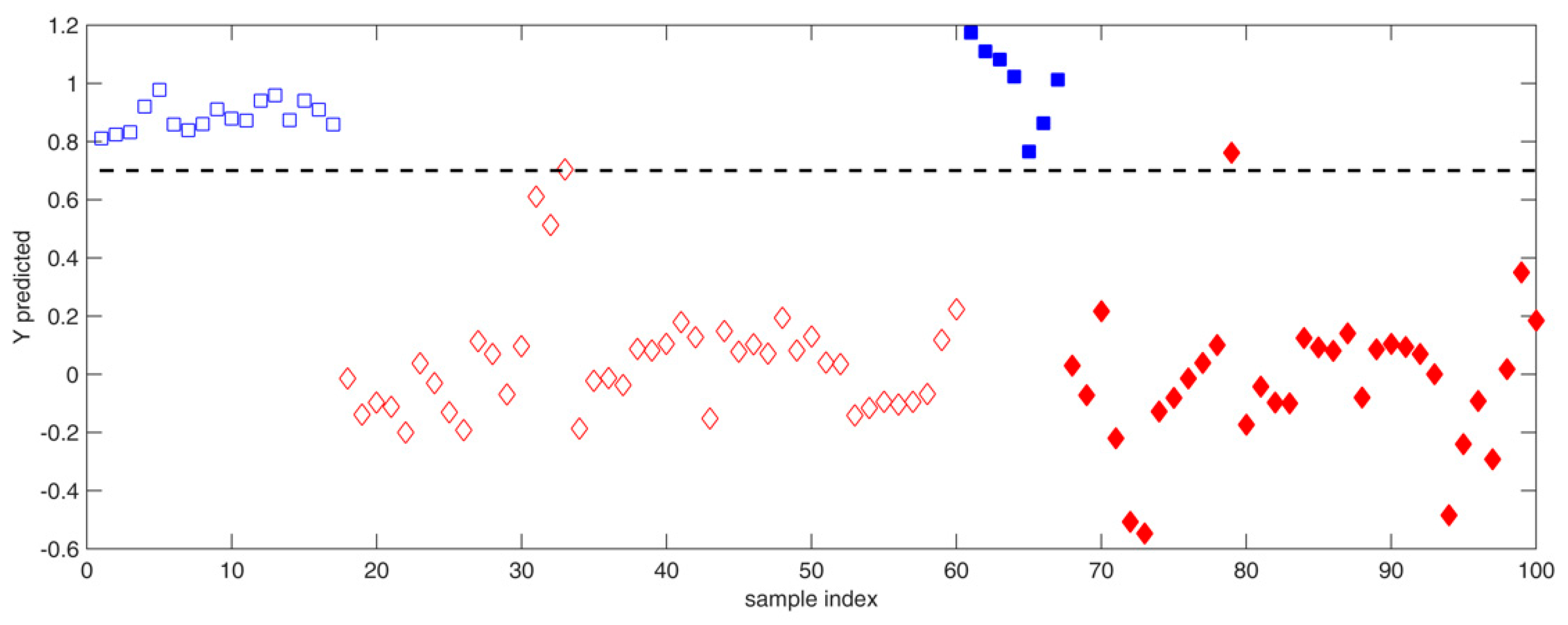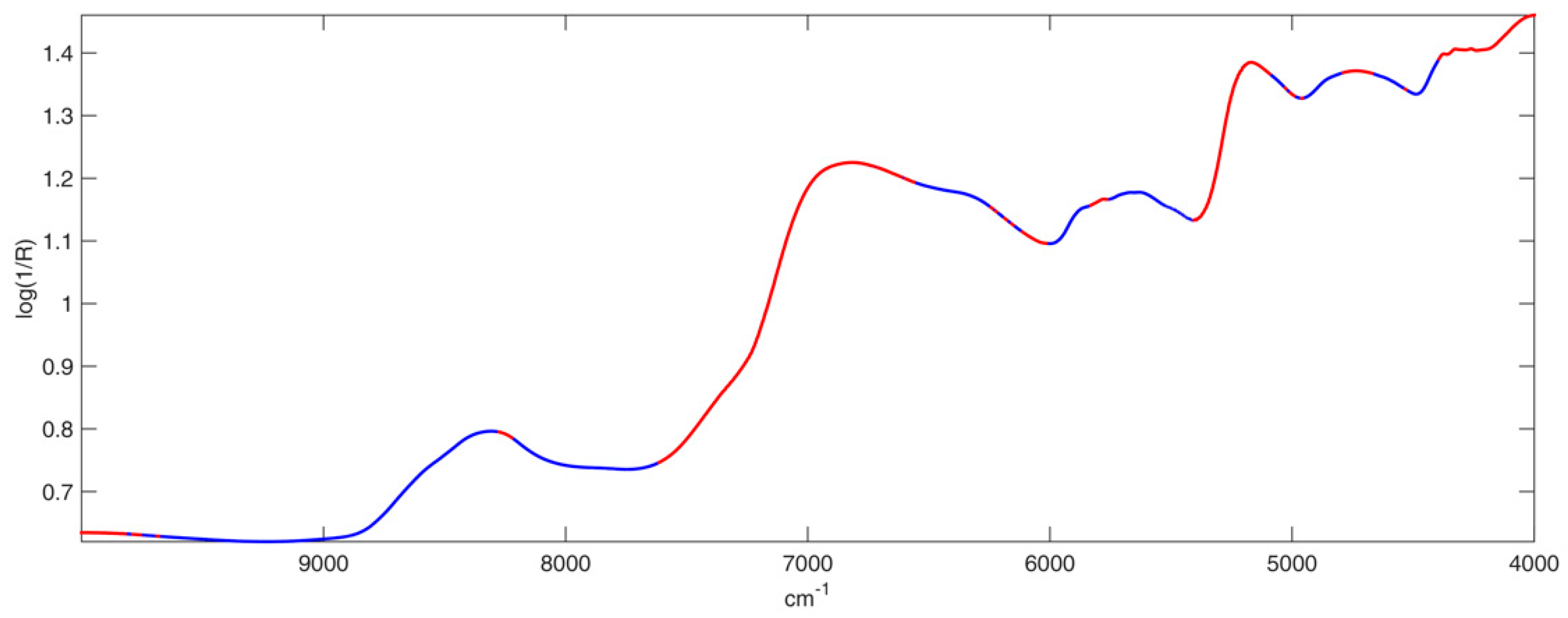Identification and Quantification of Turmeric Adulteration in Egg-Pasta by Near Infrared Spectroscopy and Chemometrics
Abstract
1. Introduction
2. Materials and Methods
2.1. Preparation of Samples
2.2. NIR Analysis
2.3. Chemometric Modeling
2.3.1. Classification Approach
2.3.2. Regression Approaches: PLS
3. Results
3.1. Detection of Adulterated Egg Pasta Samples
3.2. Quantification of the Adulterant
4. Discussion
5. Conclusions
Author Contributions
Funding
Conflicts of Interest
References
- Akıllıoğlu, H.G.; Yalcin, E. Some quality characteristics and nutritional properties of traditional egg pasta (erişte). Food Sci. Biotechnol. 2010, 19, 417–424. [Google Scholar] [CrossRef]
- Alamprese, C. The Use of Egg and Egg Products in Pasta Production. In Egg Innovations and Strategies for Improvements; Elsevier: Amsterdam, The Netherlands, 2017; pp. 251–259. [Google Scholar]
- Fuad, T.; Prabhasankar, P. Role of Ingredients in Pasta Product Quality: A Review on Recent Developments. Crit. Rev. Food Sci. Nutr. 2010, 50, 787–798. [Google Scholar] [CrossRef] [PubMed]
- Alamprese, C.; Casiraghi, E.; Primavesi, L.; Rossi, M.; Hidalgo, A. Functional and rheological characteristics of fresh egg pasta. Ital. J. Food Sci. 2005, 17, 3–15. [Google Scholar]
- Kotha, R.R.; Luthria, D. Curcumin: Biological, Pharmaceutical, Nutraceutical, and Analytical Aspects. Molecules 2019, 24, 2930. [Google Scholar] [CrossRef] [PubMed]
- Huang, H.; Yu, H.; Xu, H.; Ying, Y. Near infrared spectroscopy for on/in-line monitoring of quality in foods and beverages: A review. J. Food Eng. 2008, 87, 303–313. [Google Scholar] [CrossRef]
- Karoui, R.; Debaerdemaeker, J. A review of the analytical methods coupled with chemometric tools for the determination of the quality and identity of dairy products. Food Chem. 2007, 102, 621–640. [Google Scholar] [CrossRef]
- De Luca, S.; Ciotoli, E.; Biancolillo, A.; Bucci, R.; Magrì, A.D.; Marini, F. Simultaneous quantification of caffeine and chlorogenic acid in coffee green beans and varietal classification of the samples by HPLC-DAD coupled with chemometrics. Environ. Sci. Pollut. Res. 2018, 25, 28748–28759. [Google Scholar] [CrossRef]
- Di Donato, F.; Di Cecco, V.; Torricelli, R.; D’Archivio, A.A.; Di Santo, M.; Albertini, E.; Veronesi, F.; Garramone, R.; Aversano, R.; Marcantonio, G.; et al. Discrimination of Potato (Solanum tuberosum L.) Accessions Collected in Majella National Park (Abruzzo, Italy) Using Mid-Infrared Spectroscopy and Chemometrics Combined with Morphological and Molecular Analysis. Appl. Sci. 2020, 10, 1630. [Google Scholar] [CrossRef]
- Firmani, P.; De Luca, S.; Bucci, R.; Marini, F.; Biancolillo, A. Near infrared (NIR) spectroscopy-based classification for the authentication of Darjeeling black tea. Food Control. 2019, 100, 292–299. [Google Scholar] [CrossRef]
- Lammertyn, J.; Nicolaï, B.; Ooms, K.; De Smedt, V.; De Baerdemaeker, J. non-destructive measurement of acidity, soluble Solids, and firmness of jonagold apples using nir-spectroscopy. Trans. ASAE 1998, 41, 1089–1094. [Google Scholar] [CrossRef]
- Casale, M.; Oliveri, P.; Casolino, C.; Sinelli, N.; Zunin, P.; Armanino, C.; Forina, M.; Lanteri, S. Characterisation of PDO olive oil Chianti Classico by non-selective (UV-visible, NIR and MIR spectroscopy) and selective (fatty acid composition) analytical techniques. Anal. Chim. Acta 2012, 712, 56–63. [Google Scholar] [CrossRef] [PubMed]
- Biancolillo, A.; De Luca, S.; Bassi, S.; Roudier, L.; Bucci, R.; Magrì, A.D.; Marini, F. Authentication of an Italian PDO hazelnut (“Nocciola Romana”) by NIR spectroscopy. Environ. Sci. Pollut. Res. 2018, 25, 28780–28786. [Google Scholar] [CrossRef] [PubMed]
- Ríos-Reina, R.; Callejón, R.M.; Savorani, F.; Amigo, J.M.; Cocchi, M. Data fusion approaches in spectroscopic characterization and classification of PDO wine vinegars. Talanta 2019, 198, 560–572. [Google Scholar] [CrossRef] [PubMed]
- Ståhle, L.; Wold, S. Partial least squares analysis with cross-validation for the two-class problem: A Monte Carlo study. J. Chemom. 1987, 1, 185–196. [Google Scholar] [CrossRef]
- Lwin, T.; Martens, H.; Naes, T. Multivariate Calibration; John Wiley & Sons: New York, NY, USA, 1991. [Google Scholar]
- Geladi, P.; Kowalski, B.R. Partial least-squares regression: a tutorial. Anal. Chim. Acta 1986, 185, 1–17. [Google Scholar] [CrossRef]
- Barker, M.; Rayens, W. Partial least squares for discrimination. J. Chemom. 2003, 17, 166–173. [Google Scholar] [CrossRef]
- Pérez, N.F.; Ferré, J.; Boqué, R.; Baldrich, J.F. Calculation of the reliability of classification in discriminant partial least-squares binary classification. Chemom. Intell. Lab. Syst. 2009, 95, 122–128. [Google Scholar] [CrossRef]
- Snee, R.D. Validation of regression models: Methods and examples. Technometrics 1977, 19, 415–428. [Google Scholar] [CrossRef]
- Savitzky, A.; Golay, M.J.E. Smoothing and Differentiation of Data by Simplified Least Squares Procedures. Anal. Chem. 1964, 36, 1627–1639. [Google Scholar] [CrossRef]
- Barnes, R.J.; Dhanoa, M.S.; Lister, S.J. Standard Normal Variate Transformation and De-Trending of Near-Infrared Diffuse Reflectance Spectra. Appl. Spectrosc. 1989, 43, 772–777. [Google Scholar] [CrossRef]
- Geladi, P.; MacDougall, D.; Martens, H. Linearization and Scatter-Correction for Near-Infrared Reflectance Spectra of Meat. Appl. Spectrosc. 1985, 39, 491–500. [Google Scholar] [CrossRef]
- Wold, S.; Johansson, E.; Cocchi, M. PLS: partial least squares projections to latent structures. In 3D QSAR in Drug Design: Theory, Methods and Applications; Kubinyi, H., Ed.; KLUWER ESCOM Science Publisher: Leiden, The Netherlands, 1993; pp. 523–550. [Google Scholar]
- Cocchi, M.; Biancolillo, A.; Marini, F. Chemometric Methods for Classification and Feature Selection. In Data 267 Analysis for Omic Sciences: Methods and Applications, Comprehensive Analytical Chemistry; Jaumot, J., Bedia, C., Tauler, R., Eds.; Elsevier: Amsterdam, The Netherlands, 2018; Volume 82, pp. 265–299. [Google Scholar] [CrossRef]
- Kim, Y.-J.; Lee, H.J.; Shin, H.-S.; Shin, Y. Near-infrared Reflectance Spectroscopy as a Rapid and Non-destructive Analysis Tool for Curcuminoids in Turmeric. Phytochem. Anal. 2014, 25, 445–452. [Google Scholar] [CrossRef] [PubMed]
- Kar, S.; Tudu, B.; Jana, A.; Bandyopadhyay, R. FT-NIR spectroscopy coupled with multivariate analysis for detection of starch adulteration in turmeric powder. Food Addit. Contam. Part A 2019, 36, 863–875. [Google Scholar] [CrossRef] [PubMed]



| Adulteration (%w/w) |
|---|
| 0.01 0.025 |
| 0.05 |
| 0.075 |
| 0.085 |
| 0.090 0.10 |
| 0.15 0.20 |
| 0.25 |
| 0.30 0.35 |
| 0.40 |
| 0.45 0.50 |
| 0.60 |
| 0.75 |
| 0.85 1.00 |
| x | Calibration Set | Validation Set | ||
|---|---|---|---|---|
| Class Law-Conformant | Class Adulterated | Class Law-Conformant | Class Adulterated | |
| No. of samples | 17 | 43 | 7 | 33 |
| Total samples | 60 | 40 | ||
| Model | Pretreatment | LVs | Correct Classification Rate in Cross-validation (%) | |
|---|---|---|---|---|
| Class Law-Conformant | Class Adulterated | |||
| Model I | Mean Centering (MC) | 3 | 100.0 | 83.7 |
| Model II | 1st derivative (+MC) | 4 | 94.1 | 88.4 |
| Model III | 2nd derivative (+MC) | 9 | 76.5 | 100.0 |
| Model IV | SNV (+MC) | 8 | 100.0 | 90.7 |
| Model V | SNV+1st derivative (+MC) | 4 | 94.1 | 93.0 |
| Model VI | SNV+2nd derivative (+MC) | 9 | 70.6 | 100.0 |
| Model VII | MSC (+MC) | 9 | 100.0 | 95.3 |
| Model | Pretreatment | LVs | Root Mean Square Error in Cross-Validation (RMSECV, %w/w) |
|---|---|---|---|
| Model I | Mean Centering (MC) | 9 | 0.128 |
| Model II | 1st derivative (+MC) | 9 | 0.123 |
| Model III | 2nd derivative (+MC) | 8 | 0.130 |
| Model IV | SNV (+MC) | 8 | 0.112 |
| Model V | SNV+1st derivative (+MC) | 8 | 0.112 |
| Model VI | SNV+2nd derivative (+MC) | 8 | 0.740 |
| Model VII | MSC (+MC) | 6 | 0.123 |
© 2020 by the authors. Licensee MDPI, Basel, Switzerland. This article is an open access article distributed under the terms and conditions of the Creative Commons Attribution (CC BY) license (http://creativecommons.org/licenses/by/4.0/).
Share and Cite
Biancolillo, A.; Santoro, A.; Firmani, P.; Marini, F. Identification and Quantification of Turmeric Adulteration in Egg-Pasta by Near Infrared Spectroscopy and Chemometrics. Appl. Sci. 2020, 10, 2647. https://doi.org/10.3390/app10082647
Biancolillo A, Santoro A, Firmani P, Marini F. Identification and Quantification of Turmeric Adulteration in Egg-Pasta by Near Infrared Spectroscopy and Chemometrics. Applied Sciences. 2020; 10(8):2647. https://doi.org/10.3390/app10082647
Chicago/Turabian StyleBiancolillo, Alessandra, Angela Santoro, Patrizia Firmani, and Federico Marini. 2020. "Identification and Quantification of Turmeric Adulteration in Egg-Pasta by Near Infrared Spectroscopy and Chemometrics" Applied Sciences 10, no. 8: 2647. https://doi.org/10.3390/app10082647
APA StyleBiancolillo, A., Santoro, A., Firmani, P., & Marini, F. (2020). Identification and Quantification of Turmeric Adulteration in Egg-Pasta by Near Infrared Spectroscopy and Chemometrics. Applied Sciences, 10(8), 2647. https://doi.org/10.3390/app10082647







